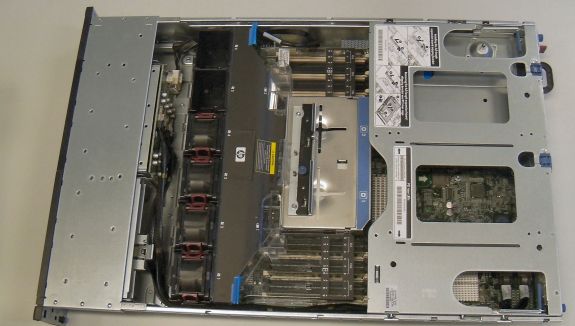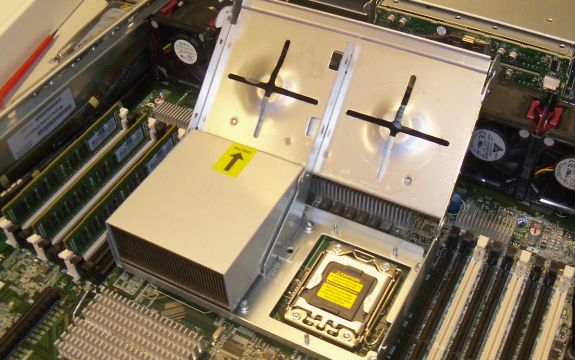Server Clash: DELL's Quad Opteron DELL R815 vs HP's DL380 G7 and SGI's Altix UV10
by Johan De Gelas on September 9, 2010 7:30 AM EST- Posted in
- IT Computing
- AMD
- Intel
- Xeon
- Opteron
HP Proliant DL380 G7
| CPU | Two Xeon X5670 at 2.93GHz |
| RAM | 15 x 4GB Samsung 1333MHz CH9 |
| Motherboard | HP proprietary? |
| Chipset | Intel 5520 |
| BIOS version | P67 |
| PSU | 2 x HP PS-2461-1C-LF 460W HE |
The 15x 4GB is not a typo. We wanted to give each server the same amount of memory while making sure that each system was working at the highest performance. In other words, each memory channel had be populated. In case of the HP DL380 G7 we populated the nine DIMMs of the first CPU, and the second CPU only got six DIMMs. This way each channel was populated, and the amount of memory (60GB) was close enough to the other systems (64GB). The extra power that one DIMM would add to the power consumption is taken in to account in the energy measurements. A DDR3 DIMM adds about 4W on average while being active.
The HP DL380 line is probably the most popular server in the world. It comes standard with four fans and one CPU. If you buy a second CPU, two fans are added to the design. The DL380 has eight 2.5 inch drive bays.

HP’s engineers have implemented quite a few great ideas: the number of sensors and the integration with the management software (ILO) is great. Lots of LEDs at the front panel give feedback to the administrator. The HP server ships with a PSU that is 92% or 94% efficient, and thus qualifies as an “80PLUS Gold” PSU. The second redundant PSU can be configured as being "cold redudant", not consuming a single watt when it is not necessary.
The CPU heatsinks can be placed on the CPU, and you simply have to close a metal “heatsink cage” to make sure that the heatsinks are applying the proper pressure on the CPUs. That makes replacing CPUs effortless and very safe.
But we are less enthusiastic about some of the “product differentiation choices”. For some weird reason, HP’s servers always ship with a few 1GB DIMMS even if you have customized the server with several tens of gigabytes. The servers is delivered with eight dummy drive bays, and you only get the functional drive bays for each disk that you order. The I/O cage is only fitted with one riser card: another optional riser card must be ordered separately. While this makes sense for HP as a vendor, in our opinion it is not customer friendly. This leads in many cases to extra deployment delays as buyers have to order something extra after the server has arrived.












51 Comments
View All Comments
jdavenport608 - Thursday, September 9, 2010 - link
Appears that the pros and cons on the last page are not correct for the SGI server.Photubias - Thursday, September 9, 2010 - link
If you view the article in 'Print Format' than it shows correctly.Seems to be an Anandtech issue ... :p
Ryan Smith - Thursday, September 9, 2010 - link
Fixed. Thanks for the notice.yyrkoon - Friday, September 10, 2010 - link
Hey guys, you've got to do better than this. The only thing that drew me to this article was the Name "SGI" and your explanation of their system is nothing.Why not just come out and say . . " Hey, look what I've got pictures of". Thats about all the use I have for the "article". Sorry if you do not like that Johan, but the truth hurts.
JohanAnandtech - Friday, September 10, 2010 - link
It is clear that we do not focus on the typical SGI market. But you have noticed that from the other competitors and you know that HPC is not our main expertise, virtualization is. It is not really clear what your complaint is, so I assume that it is the lack of HPC benchmarks. Care to make your complaint a little more constructive?davegraham - Monday, September 13, 2010 - link
i'll defend Johan here...SGI has basically cornered themselves into the cloud scale market place where their BTO-style of engagement has really allowed them to prosper. If you wanted a competitive story there, the Dell DCS series of servers (C6100, for example) would be a better comparison.cheers,
Dave
tech6 - Thursday, September 9, 2010 - link
While the 815 is great value where the host is CPU bound, most VM workloads seem to be memory limited rather than processing power. Another consideration is server (in particularly memory) longevity which is something where the 810 inherits the 910s RAS features while the 815 misses out.I am not disagreeing with your conclusion that the 815 is great value but only if your workload is CPU bound and if you are willing to take the risk of not having RAS features in a data center application.
JFAMD - Thursday, September 9, 2010 - link
True that there is a RAS difference, but you do have to weigh the budget differences and power differences to determine whether the RAS levels of either the R815 (or even a xeon 5600 system) are not sufficient for your application. Keep in mind that the xeon 7400 series did not have these RAS features, so if you were comfortable with the RAS levels of the 7400 series for these apps, then you have to question whether the new RAS features are a "must have". I am not saying that people shouldn't want more RAS (everyone should), but it is more a question of whether it is worth paying the extra price up front and the extra price every hour at the wall socket.For virtualization, the last time I talked to the VM vendors about attach rate, they said that their attach rate to platform matched the market (i.e. ~75% of their software was landing on 2P systems). So in the case of virtualization you can move to the R815 and still enjoy the economics of the 2P world but get the scalability of the 4P products.
tech6 - Thursday, September 9, 2010 - link
I don't disagree but the RAS issue also dictates the longevity of the platform. I have been in the hosting business for a while and we see memory errors bring down 2 year+ old HP blades in alarming numbers. If you budget for a 4 year life cycle, then RAS has to be high on your list of features to make that happen.mino - Thursday, September 9, 2010 - link
Generally I would agree except that 2yr old HP blades (G5) are the worst way to ascertain commodity x86 platform reliability.Reasons:
1) inadequate cooling setup (you better keep c7000 input air well below 20C at all costs)
2) FBDIMM love to overheat
3) G5 blade mobos are BIG MESS when it comes to memory compatibility => they clearly underestimated the tolerances needed
4) All the points above hold true at least compared to HS21* and except 1) also against bl465*
Speaking about 3yrs of operations of all three boxen in similar conditions. The most clear thi became to us when building power got cutoff and all our BladeSystems got dead within minutes (before running out of UPS by any means) while our 5yrs old BladeCenter (hosting all infrastructure services) remained online even at 35C (where the temp platoed thanks to dead HP's)
Ironically, thanks to the dead production we did not have to kill infrastructure at all as the UPS's lasted for the 3 hours needed easily ...